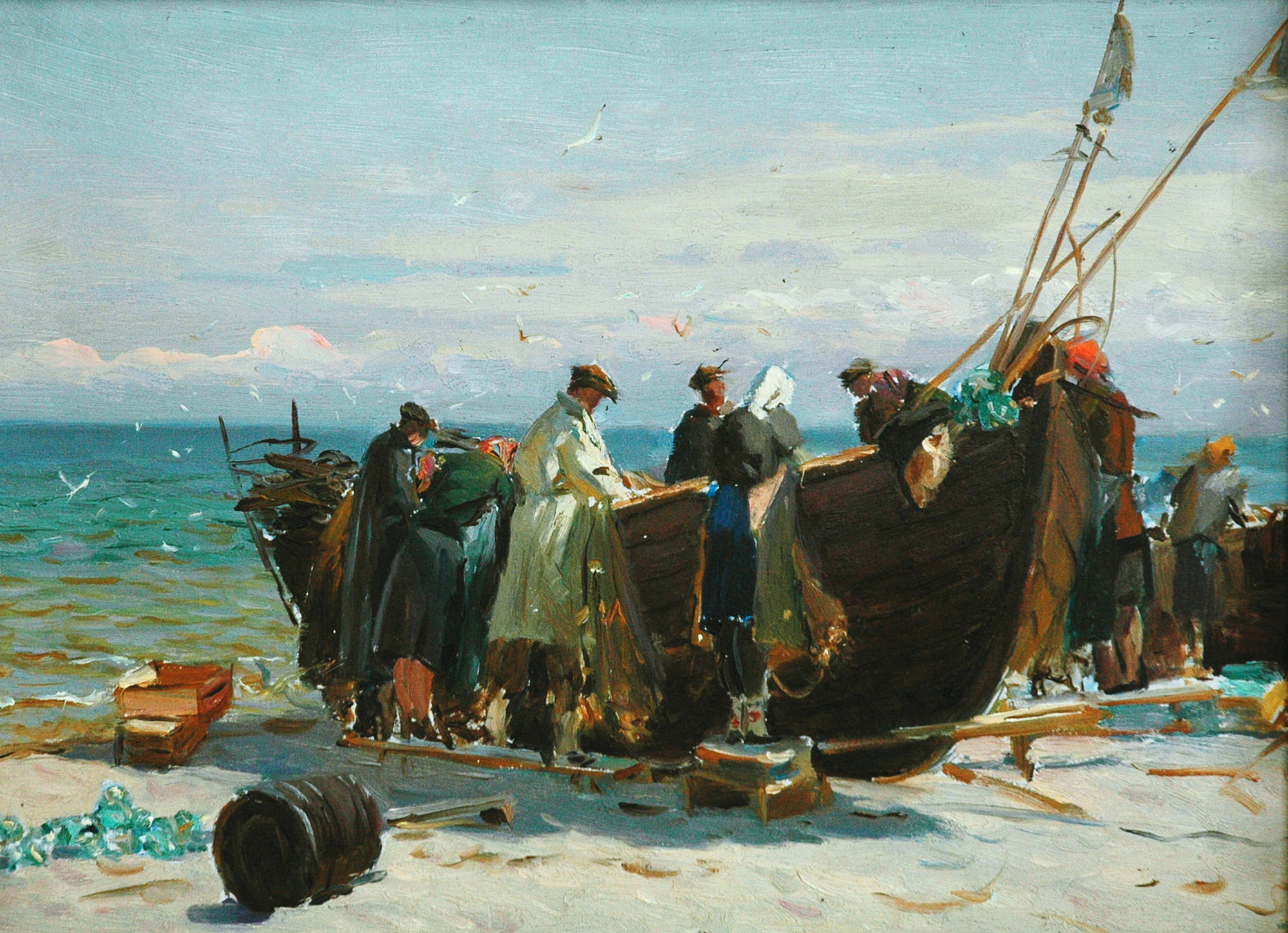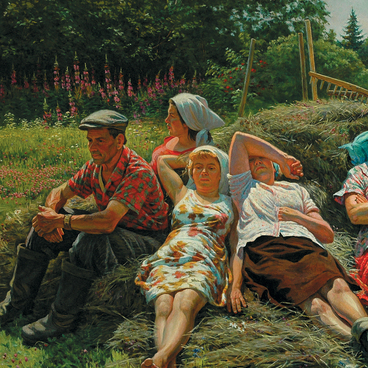The Republic of Latvia officially joined the USSR in 1940. Fishery is one of the most important sectors of the national economy. By the end of the 1940s, a chain of fishing cooperatives and collective farms had been established along the Baltic coast to fish in the sea and fresh waters. The Bolshevik collective farm was the largest in Latvia. Fishermen were united in collective farms on a voluntary basis in order to carry out joint fishing activities. Members of the collective farm pooled their property and cash contributions and shared profits.
Yablokov’s painting depicts a fishing boat that has just come ashore after fishing. At least seven people are working around it – perhaps they are the members of the fishing cooperative with their families. We cannot see the faces of the people, their figures are depicted in a rather schematic and generalized manner. However, the postures and concentrated movements clearly give the impression of hard daily work.
Anatoly Yablokov was born in 1928 in Kostroma Region. He worked as a designer in Kostroma. A meeting with Konstantin Maksimov, People’s Artist of the RSFSR, had a great influence on Yablokov’s creative activities. Maksimov painted genre scenes, portraits and landscapes, depicting the work and life of Russian people. A realist painter, he was able to instil in Yablokov a love for the accurate conveying the plot of a work, along with a subtle sense of the environment.
Yablokov’s landscapes were a great success. In 1946, his painting The Green Tower of the Ipatyev Monastery was purchased for the Shchusev State Museum of Architecture and won the jury award at an all-Union competition.
However, the painter’s interests extended beyond nature and architecture. Scenes and characters related to the sea are also not uncommon in his works. Perhaps, this is due to the fact that he was educated at the Odessa Art School. In the picture Riga Fishermen, the image of the sky and sea is no less important than the main characters in the painting. The dazzling sunlight and white sand perfectly complement the many shades of blue and green. The viewer is presented with a bright picture of a sunny spring day on the Riga seashore. Despite the realistic message of the work, a certain mood can be sensed. The viewer wants to stare at the picture and look over the boundless sky, which is made up from the endless shades of blue and grey. The picture does not provoke an internal conflict, it is balanced terms of both in colour and emotional tonality. The painting was restored in 2014.
Yablokov’s painting depicts a fishing boat that has just come ashore after fishing. At least seven people are working around it – perhaps they are the members of the fishing cooperative with their families. We cannot see the faces of the people, their figures are depicted in a rather schematic and generalized manner. However, the postures and concentrated movements clearly give the impression of hard daily work.
Anatoly Yablokov was born in 1928 in Kostroma Region. He worked as a designer in Kostroma. A meeting with Konstantin Maksimov, People’s Artist of the RSFSR, had a great influence on Yablokov’s creative activities. Maksimov painted genre scenes, portraits and landscapes, depicting the work and life of Russian people. A realist painter, he was able to instil in Yablokov a love for the accurate conveying the plot of a work, along with a subtle sense of the environment.
Yablokov’s landscapes were a great success. In 1946, his painting The Green Tower of the Ipatyev Monastery was purchased for the Shchusev State Museum of Architecture and won the jury award at an all-Union competition.
However, the painter’s interests extended beyond nature and architecture. Scenes and characters related to the sea are also not uncommon in his works. Perhaps, this is due to the fact that he was educated at the Odessa Art School. In the picture Riga Fishermen, the image of the sky and sea is no less important than the main characters in the painting. The dazzling sunlight and white sand perfectly complement the many shades of blue and green. The viewer is presented with a bright picture of a sunny spring day on the Riga seashore. Despite the realistic message of the work, a certain mood can be sensed. The viewer wants to stare at the picture and look over the boundless sky, which is made up from the endless shades of blue and grey. The picture does not provoke an internal conflict, it is balanced terms of both in colour and emotional tonality. The painting was restored in 2014.



